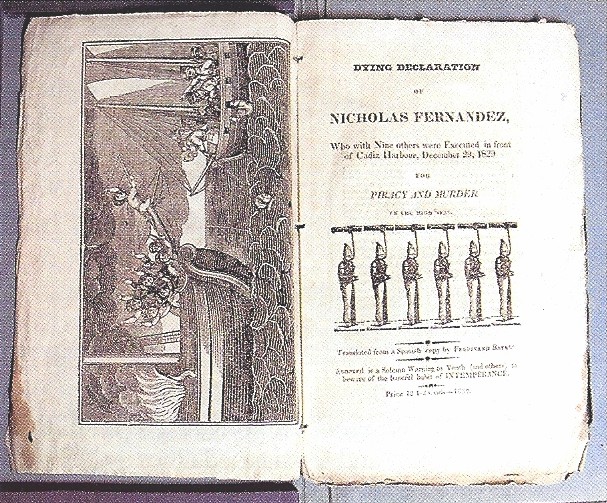Books of the Sea from Ten Pound Island Book Co.
- by Michael Stillman

Books of the Sea from Ten Pound Island Book Co.
Piracy wasn't limited to the French and Spanish. No, there were some good old Americans involved in the trade as well. Samuel Tully and John Dalton were two such individuals, but they were not the standard, board, kill and steal type. They were mates on the schooner George Washington. The George Washington had picked up some wine and cash in the Cape Verde Islands when the two seized control. At some point they threw a man overboard, leading to an indictment back in the U.S. for piracy, larceny and murder. The two were convicted, but Dalton, being just an accessory, was pardoned by President Madison. Tully was not so lucky. Item 12 is a broadside, The Last Words of S. Tully, published in December 1812, at which time Tully was strung up before a crowd of 10,000 in South Boston and sent to his eternal reward or punishment. Tully was properly chastened in his last words, asking God's forgiveness and wishing others heed the warning of his terrible fate, but he was hung anyway. $3,500.
In 1852, Capt. Robert Jenks published a system of providing ship-to-ship (or on land) signals that could be seen as far as a telescope can see. He called it The Brachial Telegraph, an Original Method of Conversing and Signaling on Land and at Sea, by Means of Human Arms. The arms would be held in different positions to display the letters of the alphabet. Think of the YMCA dance. Additionally, there were various brachial (pertaining to the arm) positions that spelled out common phrases. It was sort of the earliest form of wireless communication. Item 29. $500.
Perhaps the greatest of all French explorers was Jean-Francois de La Perouse. His voyage to the Pacific brought him along the west coast of America, to Japan, Russia, China and Australia. At various points, he sent his commentaries back to France overland. It was a good thing, because after departing Australia, he and his two ships disappeared, never to be seen again. Missions were dispatched by his concerned compatriots, but none was successful. It would not be until 40 years later that remnants of his ships were accidentally discovered on an isolated Pacific Island. His official account is a highly collectible work, but here is an obscure La Perouse item not so often found. It comes from the centennial observance of his death, in 1888. Published by the French Societe de Geographie, it is titled Centenaire de la Mort de La Perouse… Item 67. $250
Ten Pound Island Book Company may be reached at 978-283-5299 or tenpound@tenpound.com. Their website is www.tenpound.com.